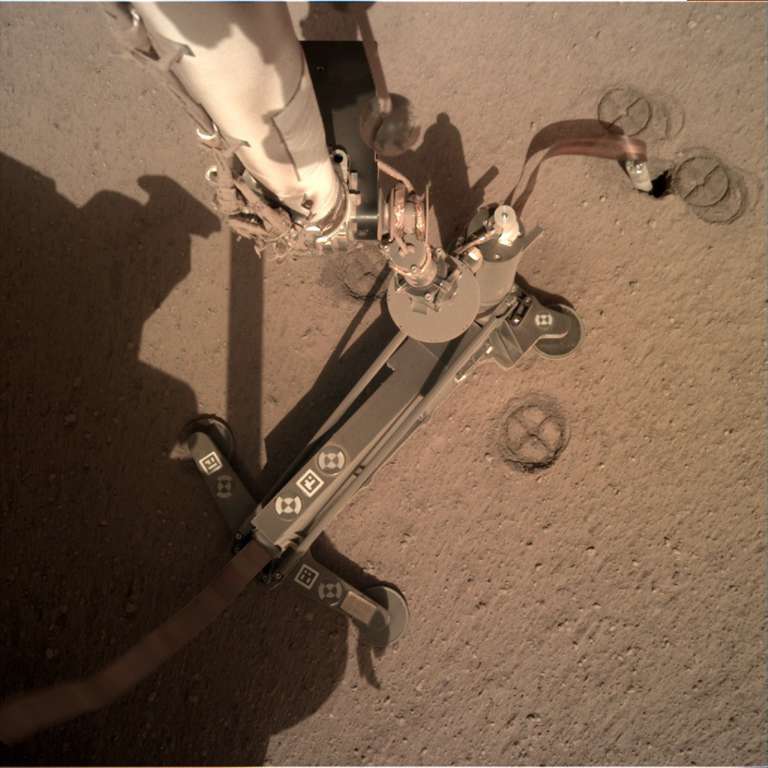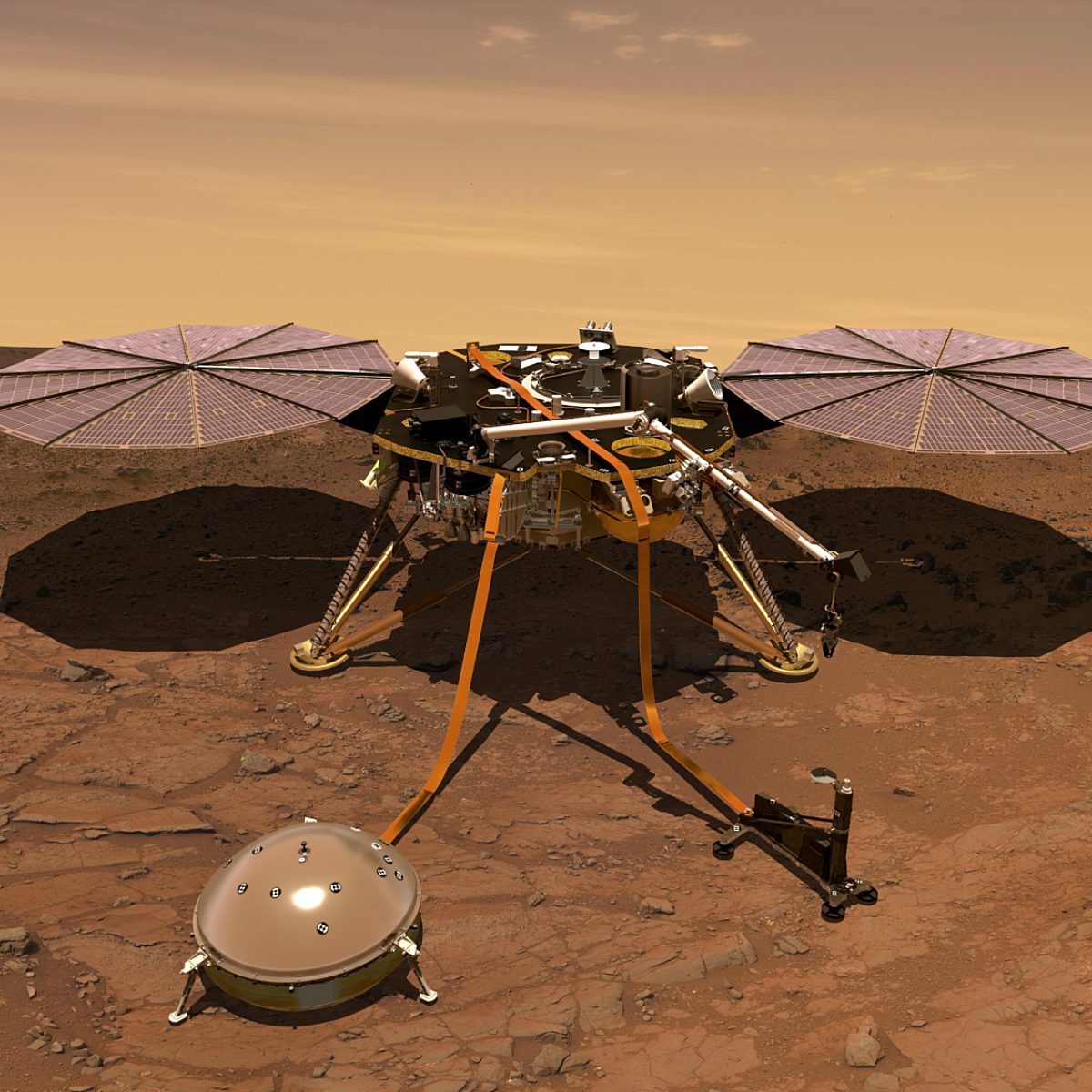Emily Lakdawalla • Jul 02, 2019
InSight Update: A Couple More Tiny Quakes and Heat Probe Progress
It’s been 3 months since my last check-in with the InSight mission. In that time, they’ve detected a few more very small Marsquakes, including the largest yet, coming in at a magnitude 3.0, reported via the SEIS instrument Twitter feed on June 5. I’m looking forward to the Ninth International Conference on Mars in about 3 weeks, when there will be several presentations on scientific results from team members representing the seismometer, magnetometer, weather, and heat probe instruments.
While we’re waiting for science results, the main item of interest on InSight has been the continuing work to solve the problem with the Heat Flow and Physical Properties Probe (HP3, pronounced "H-P-cubed"). Its main component is a self-hammering mole that’s supposed to jackhammer 5 meters down into the Martian soil, unreeling an instrumented tether that it’ll use to measure the rate of heat flow out of the Martian interior and also the way that the Martian surface responds to daily and seasonal temperature changes. The issue is that the self-hammering mole hasn’t managed to penetrate the surface, stopping at roughly 20 centimeters depth despite very insistent hammering. As part of the anomaly recovery effort, last weekend mission engineers lifted the mole’s housing completely off the surface and set it down elsewhere, exposing the top of the mole sticking out a hole that is, very surprisingly, more than twice as wide as the mole. More on the mole hole below.

InSight, NASA's Mars lander that studied the planet's interior
InSight was a Mars lander studying the red planet's interior to learn how other worlds are made.
Exposing the Mole Hole
This was a risky operation. HP3 team lead Tilmann Spohn wrote on 6 June in his excellent and detailed logbook on the DLR website: “If the Mole or the tether are indeed snagged in the [HP3 support structure assembly], then we may actually pull the mole out. Therefore, [an] operations scheme has been designed where the lifting occurs in several steps with careful examinations on the way. This is then the major reason why the operation will take a while, until mid next month or possibly even later.”
Here is how it went down:
- Sol 182 (1 June): Unstow grapple and test actuation (stowed grapple - unstowed grapple - wiggle - wiggle)
- Sol 185 (4 June): Position grapple over HP3 grapple point (pic)
- Sol 189 (9 June): Open grapple - drop grapple - close grapple
- Sol 193 (13 June): Lift arm, taking up slack (pic)
- Sol 203 (23 June): Lift arm, lifting HP3 housing 12 centimeters, exposing the mole in its hole (animation, via the DLR blog, and a picture after the lift)
- Sol 209 (29 June): Lift arm, lifting HP3 housing a further 13 centimeters to a total of 25 centimeters (pic, and notice how taut the flat tether cable connecting the mole to the lander is)
- Sol 209 (29 June, continued): Place HP3 housing on the ground between InSight and the mole hole (pic)
As I mentioned, the great size of the hole around the mole was a big surprise. Spohn wrote:
The first lift already revealed the pit that surrounds the mole. I along with others from the team were a bit shocked when we saw how large the pit actually is. Its diameter is about two times the diameter of the mole. The bottom of the pit is difficult to see (we expect better images once the lift is complete) but it seems that it is about 2-2.5 mole diameters deep. A mole diameter is 27mm. So the mole must have compacted the regolith quite a bit. In addition to its own volume it must have displaced about half of its buried volume.
There seems to be a little rim surrounding the pit but most of the displacement likely was compaction. We cannot see the inclination of the wall very well but it at least seems to me that the mole was "precessing" (like a spinning top) and carved a conical hole....
In any case, the apparent compaction seems to be compatible with a large porosity, relatively low density, and with the low seismic velocity of 120 m/s reported by the SEIS team, and the low thermal inertia (200 TIU) reported by HP3. There have been suggestions that maybe there is a stone or stones at depth that the mole may have displaced and that the pit is indicating the displacement of that stone. We will have to see.
Filling the Mole Hole
The size of the mole hole is a huge surprise but is also diagnostic of the problem and indicates a (probably) workable solution. The only way to make a hole that big without actually excavating material is to compact it. In terms of materials familiar to us Earth dwellers, the soil around the mole is behaving a lot more like wet snow than it is like sand. For the mole’s self-hammering drive to work, it needs friction to keep it from just bouncing; it needs the surface to behave more like sand (or, if you’re into Minecraft, like gravel), falling into any excavated hole. If the walls of the hole are compacting rather than collapsing as the mole hammers, there’s insufficient friction, and the mole just bounces around and has no hope of penetrating. This is bad.
But. InSight has a secret weapon, a tool it wasn’t even supposed to have. It has a shovel, mounted on the end of the arm, inherited from the canceled Mars Surveyor lander mission. InSight can use the shovel to press down on the surface, tamping down the soil like you tamp dirt around a transplanted root ball, thereby enclosing the HP3 mole in sand and giving it the friction it needs to keep going. One way or another, they plan to “fill the pit,” Spohn says, and hopefully when they’ve done that the mole will be able to proceed downward.
So for the next few weeks to months, the team will keep playing in the Martian sandbox. But there’s real hope that the efforts will end with the burial of the mole, to some depth, allowing that part of InSight’s Martian experiment to begin.
Support our core enterprises
Your support powers our mission to explore worlds, find life, and defend Earth. You make all the difference when you make a gift. Give today!
Donate

 Explore Worlds
Explore Worlds Find Life
Find Life Defend Earth
Defend Earth


